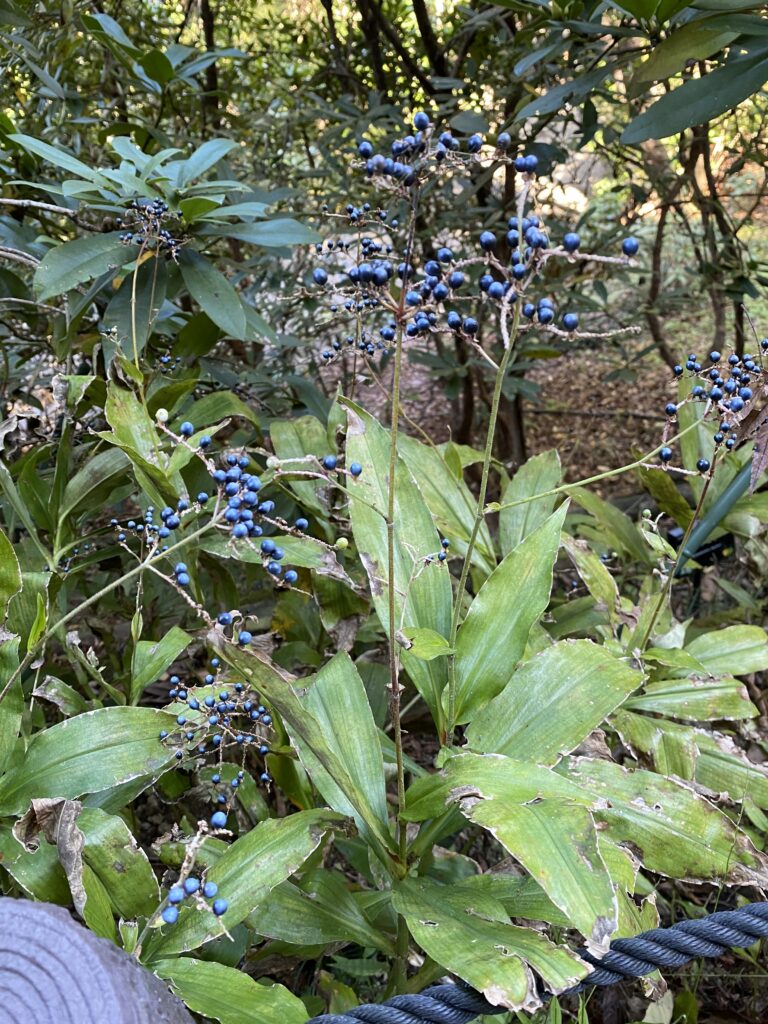





All 1-6 are hellebore (Japanese: Christmas-rose). I was surprised that they were planted in such a dark place, as I had heard that hellebore can be dark, but likes the sun quite well. However, it seems to be growing well, probably because of the ingenious way of keeping the soil dry by potting it. I’m growing some of these hellebores myself, so I’ll keep a careful eye on them.





All 7-9 are hellebores, but unlike 1-6 they are planted in the ground. However, if you look closely you can see that they are planted in raised beds, an ingenious way of keeping the soil dry.
It is closer to its natural state, with fallen leaves and moss scattered around the hellebores, welcoming them as members of the forest.
10,11 Pollia japonica (Japanese: Yabu-myoga) is native to East Asia. It often grows in humid forests. Look at the beauty of these berries. I was attracted to them and took the photos. These young shoots can be eaten.





12Oriental false hauksbread (Japanese: Onita-birako) is widely distributed from China to Australia. It was growing in raised beds in the forest.
13fuzzy pride-of-Rochester (Japanese: Maruba-Utsugi) is endemic to Japan; it is a 1-3 m shrub.The autumn leaves have started to change.
14Maple trees are famous for their autumn leaves, which are planted in many Japanese Buddhist temples and parks for people to enjoy in autumn. Usually, the autumn foliage of maple trees is at its peak from the end of October to November, but this year, due to the high temperatures, the leaves have not yet turned fully red.
15、16The Japanese rose (Japanese: Yamabuki) is a deciduous shrub native to East Asia that dies back in 3-4 years. It prefers slightly humid, semi-shady conditions. Yellow flowers appear in spring and the leaves turn yellow in autumn.






17Water mill in the botanical garden. It has a nice atmosphere.
18,19See 18 and 19. They are the same MAPLE tree, planted in the same location, but one has red leaves and the other is lush.This is the wonder of plants.
20Gassho-style houses. This is a special type of farmhouse found only in the Hida region of Gifu Prefecture, Japan. The gassho-zukuri houses of Shirakawa-go are registered as a World Heritage Site.
21、22This is the most beautiful part of the botanical garden. If you ever come to the Higashiyama Botanical Garden, you must visit. Clear water flows through it, moss grows on the surrounding trees and a sense of tranquillity pervades the place.




23There is something refreshing about this bright shade.
24Crape myrtle (Japanese: Sarusuberi) is known for its vine-like trunks and flowers that bloom continuously from July to October. It is native to southern China.
25Shasta daisy (Japanese: Shasta daisy) will see you off near the botanical garden exit. The entrance and exit of the Botanical Gardens are planted with a number of friendly horticultural varieties for visitors to enjoy.
26Japanese toad-lily (Japanese: Hototogisu) is endemic to Japan. It grows in half-shaded areas in mountainous regions. Flowers bloom from August to October. It looks like a tropical flower. I would like to finish my exploration of the botanical garden with this plant.



コメント